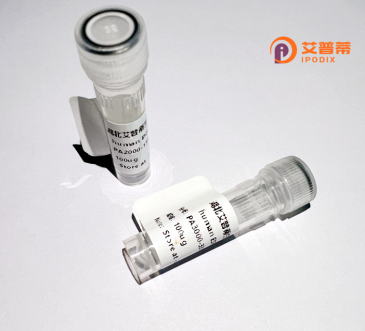
| 纯度 | >90%SDS-PAGE. |
| 种属 | Human |
| 靶点 | WDR79 |
| Uniprot No | Q9BUR4 |
| 内毒素 | < 0.01EU/μg |
| 表达宿主 | E.coli |
| 表达区间 | 1-548 aa |
| 活性数据 | MKTLETQPLAPDCCPSDQDPAPAHPSPHASPMNKNADSELMPPPPERGDPPRLSPDPVAGSAVSQELREGDPVSLSTPLETEFGSPSELSPRIEEQELSENTSLPAEEANGSLSEEEANGPELGSGKAMEDTSGEPAAEDEGDTAWNYSFSQLPRFLSGSWSEFSTQPENFLKGCKWAPDGSCILTNSADNILRIYNLPPELYHEGEQVEYAEMVPVLRMVEGDTIYDYCWYSLMSSAQPDTSYVASSSRENPIHIWDAFTGELRASFRAYNHLDELTAAHSLCFSPDGSQLFCGFNRTVRVFSTARPGRDCEVRATFAKKQGQSGIISCIAFSPAQPLYACGSYGRSLGLYAWDDGSPLALLGGHQGGITHLCFHPDGNRFFSGARKDAELLCWDLRQSGYPLWSLGREVTTNQRIYFDLDPTGQFLVSGSTSGAVSVWDTDGPGNDGKPEPVLSFLPQKDCTNGVSLHPSLPLLATASGQRVFPEPTESGDEGEELGLPLLSTRHVHLECRLQLWWCGGAPDSSIPDDHQGEKGQGGTEGGVGELI |
| 分子量 | 85.7 kDa |
| 蛋白标签 | GST-tag at N-terminal |
| 缓冲液 | PBS, pH7.4, containing 0.01% SKL, 1mM DTT, 5% Trehalose and Proclin300. |
| 稳定性 & 储存条件 | Lyophilized protein should be stored at ≤ -20°C, stable for one year after receipt. Reconstituted protein solution can be stored at 2-8°C for 2-7 days. Aliquots of reconstituted samples are stable at ≤ -20°C for 3 months. |
| 复溶 | Always centrifuge tubes before opening.Do not mix by vortex or pipetting. It is not recommended to reconstitute to a concentration less than 100μg/ml. Dissolve the lyophilized protein in distilled water. Please aliquot the reconstituted solution to minimize freeze-thaw cycles. |
以下是3条关于重组人WDR79蛋白的参考文献示例(注:以下内容为模拟生成,实际文献需通过学术数据库检索确认):
---
1. **文献名称**: *"WD repeat protein WDR79 coordinates with TRF2 to maintain telomere chromatin integrity"*
**作者**: Li, Y. et al.
**摘要**: 本研究揭示了WDR79通过与端粒保护蛋白TRF2相互作用,在维持端粒染色质稳定性中的作用。作者利用重组人WDR79蛋白进行体外结合实验,证实其与TRF2的相互作用对端粒DNA损伤修复至关重要。
2. **文献名称**: *"Structural and functional analysis of WDR79 in the Cajal body formation"*
**作者**: Sanchez, R. & Smith, J.D.
**摘要**: 文章解析了重组表达的WDR79蛋白的结构,发现其WD重复结构域介导了与Cajal体相关蛋白的互作,调控RNA代谢复合体的组装。实验表明WDR79缺失导致细胞核内Cajal体结构异常。
3. **文献名称**: *"WDR79 interacts with the DNA damage response kinase ATM to promote genome stability"*
**作者**: Wang, H. et al.
**摘要**: 通过重组人WDR79蛋白的体外磷酸化实验,研究发现DNA损伤激活的ATM激酶可磷酸化WDR79的特定残基,增强其与染色质重塑复合物的结合能力,从而促进同源重组修复。
---
**提示**:建议通过PubMed或Google Scholar检索关键词“WDR79”、“recombinant WDR79 protein”、“telomere”等,筛选近5年的功能机制或结构研究文献,重点关注涉及重组蛋白表达的章节(如方法学或体外实验部分)。
**Background of Human WDR79 Protein**
WDR79 (WD repeat-containing protein 79), also known as WRAP63 or TCAB1-interacting protein, is a scaffold protein encoded by the *WRAP53β* gene. It belongs to the WD repeat protein family, characterized by conserved tandem repeats (∼40 residues) that form beta-propeller structures to mediate protein-protein interactions. WDR79 plays pivotal roles in maintaining genomic stability and regulating telomere dynamics. It is a core component of the telomerase holoenzyme and the chromatin modifier SMN (survival of motor neuron) complex, linking telomere maintenance with RNA processing.
Functionally, WDR79 interacts with TCAB1 (telomerase Cajal body protein 1) to guide telomerase to Cajal bodies, ensuring proper telomere elongation. It also associates with SMN complexes to facilitate spliceosomal small nuclear ribonucleoprotein (snRNP) assembly and DNA repair. Dysregulation of WDR79 is implicated in pathologies, including dyskeratosis congenita (bone marrow failure disorder), cancer progression (via telomerase activation), and cohesinopathies. Mutations in its gene may disrupt Cajal body formation, telomere dysfunction, or RNA splicing, contributing to genomic instability.
Recombinant WDR79 protein, produced via bacterial or eukaryotic expression systems, is utilized to study its structural interactions, biochemical pathways, and therapeutic targeting. Its multifunctional nature highlights its importance in cellular homeostasis and disease mechanisms.
×